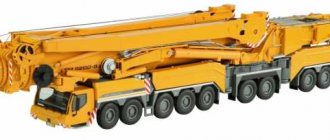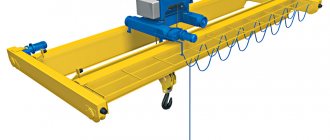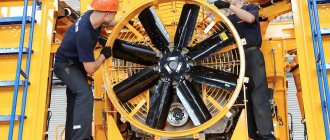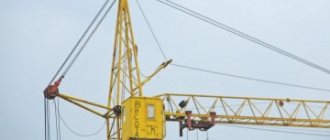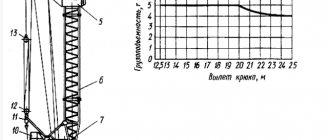The world's largest floating crane
Our MOST section already has the world's largest MOTOR CRANE and the most powerful mobile crane. And recently a record-breaking floating crane appeared.
In the middle of last year, two 1,600-ton Goliath gantry cranes working at the Hyundai Heavy Industries shipyard received very powerful reinforcements. This reinforcement is the new Hyundai-10000 floating crane, capable of lifting and moving a load six times heavier than the gantry cranes mentioned above can lift. Currently, the Hyundai-10000 crane has already been used to move huge and massive structures, for example, components of the Aasta Hansteen offshore drilling platforms, which are being built for the Norwegian company Statoil.
The 10,000-tonne floating crane is equipped with two 180-meter-long retractable booms and two 70-meter-long counterweight booms. Loads are lifted using 16 main winches and 8 additional winches. The drums of these winches wind cables with a diameter of 72 and 54 millimeters, the length of each of which is 5,700 meters. And the main lifting hook of the Hyundai-10000 crane consists of a set of eight 1,250-ton hooks.
The energy required to operate this “monster” is generated by four main generators with a capacity of 2,200 kW. When the crane operates while in the harbor and connected to the power grid, peaks in its consumption are smoothed out by the energy generated by two additional generators with a capacity of 600 kW each. And as an emergency backup generator, one 100-kilowatt generator is installed on the crane.
The design of the lifting mechanism of the Hyundai-10000 crane is designed in such a way that it can hold its load even in the most emergency situation. In the case of lifting and transporting particularly heavy and oversized cargo, special tanks are filled with sea water to give the crane additional weight and stability. Due to this, the crane is able to maintain a hook angle of 15 degrees on either side, and 20 degrees on the stern side.
The automatic control system, using various sensors, lasers and cameras, is able to automatically maintain the position of the crane with an accuracy of 100 millimeters, even when the crane is lifting a load measuring 50 meters.
“Previously, with 1,600-ton Goliaths at our disposal, we could only build and move relatively small modules. This means that our workers had to perform five times more operations to move, assemble and install these modules,” says Park Jong-bong, head of one of the departments at Hyundai Heavy Industries. “Now we we can assemble one 8,000-ton module, move it where it needs to be, and immediately install it in place with high precision.”
[sources]sourceshttps://www.maritime-executive.com/pressrelease/worlds-biggest-shear-leg-floating-crane-in-operationhttps://enki.ua/news/samyy-ogromnyy-plavuchiy-kran-v -mire-stroit-gigantskuyu-morskuyu-platformu-4914
But in general, the largest car in the world and the largest jet engine in the world. See the World's Most Powerful Fire Truck and "Spaceship" in Antarctica
masterok.livejournal.com
Giant floating crane
Many cranes are great for land-based work, but what about offshore cargo? There are other machines for this - floating cranes. And one of them is “Asian Hercules II”.
Singapore. This is where the leaders of the oil business turn their eyes when they need a new drilling rig. At the busiest shipyard they are built by the dozens. Huge structures are assembled from ready-made units and components weighing about 3,000 tons, and the Asian Hercules II floating crane assists in such assembly.
Built in 1996 at Keppel Nantong Shipyard in China for $45 million, the Asian Hercules II cargo-lifting vessel became the largest in Europe and Asia. With a length of 91 m and a width of 43 m, its area is equal to the area of a football field. This floating giant weighs 10,560 tons. A permanent crew of 24 sailors is required to maintain the floating crane. The owner of the floating crane is the Singaporean company Asian Lift. At the moment, the fleet of this company includes 5 floating cranes, and the flagship is the Asian Hercules II with a lifting capacity of 3200 tons.
"Asian Hercules II" is one of the largest floating cranes in the world. Piece by piece, piece by piece, he's helping to assemble ocean oil platforms. Almost 180 m high, this full-fledged vessel can be called in one word “Hercules” both in name and in essence. Four 830 kW winches and 4.5 km of steel cables allow the floating crane to lift a load weighing more than 3 thousand tons. 8 steel cables are used for lifting. The fixation of steel hooks is carried out by riggers who have undergone many hours of training in lifting operations. To remove the trim, the floating crane takes water equal to the weight of the cargo into the ballast feed tanks. In the pilothouse, the captain monitors the intake of water on the inclinometer of the control panel in order to receive the strictly required volume of water entering through three water pumps. One of the advantages of this floating crane is its increased maneuverability. This was made possible by four rudder propellers with a power of 1100 hp. each.
the largest floating crane in the world “Asian Hercules II” photo
A floating crane transports the tilting Millennium Bridge in Northern England
The Asian Hercules II is a huge flat-bottomed self-propelled barge with a huge A-frame and a large number of lifting and mooring winches. This floating crane is designed for large lifting projects such as oil rig installation, building structural installation, bridge installation and the like. With 9 thousand hp. This muscular vessel is so strong that it can lift 3,200 tons of iron and steel, which is equivalent to the weight of 4,000 cars.
The floating crane "Asian Hercules II" will always come to the rescue if you need to move huge objects. In November 2000, the floating crane completed one of its most difficult tasks. It traveled 9.5 km along the River Tyne in the northern English city of Newcastle upon Tyne and delivered the pride of England - the world's first tilting Gateshead Bridge - the Millennium Bridge, costing 34 million dollars. Its weight is 850 tons. This unique 125 meter bridge contains so much steel that it would be enough for 64 omnibuses. The floating crane "Asian Hercules II" was the only vessel capable of helping in the installation of this unique structure. If it were not for his capabilities, the work would have to be done in parts, and this would take a very long time. For three days, the “Asian Hercules” held the load, towering over the city with unimaginable weight. After which the bridge was securely fixed in place.
"Asian Hercules" is a real giant compared to other cranes. On the water he can do work that no one else can do.
Technical data of the floating crane "Asian Hercules II": Displacement - 10560 tons; Length - 91.35 m; Width - 43.35 m; Minimum draft - 2.75 m; Maximum draft - 8.5 m; Power plant - four propellers - steering units of 813 kW; Crew - 24 people; Load capacity - 3200 tons; Speed - 7 knots;
korabley.net
The largest tower crane
Among the tower cranes, the giant crane from Wolffkran is the 1250B model. The maximum load moment of the crane is 1500 tons, this giant has a lifting capacity of 60 tons. The maximum radius of the boom is 80 meters, and at its maximum radius it can lift a load weighing 11 tons.
This large crane immediately after the presentation went to its first job - building a hydroelectric power station in Germany. The manufacturer of the crane claims that today it is very popular in many countries of the world (Europe, America, Australia, the Middle East). No more than 15 such cranes are produced per year, and the price for them is determined depending on the configuration, but still the cost is incredibly high. Therefore, in order to save customers money, manufacturers even offer this crane for rent.
The world's largest floating crane (3 photos)
In the middle of last year, two 1,600-ton Goliath gantry cranes working at the Hyundai Heavy Industries shipyard received very powerful reinforcements. This reinforcement is the new Hyundai-10000 floating crane, capable of lifting and moving a load six times heavier than the gantry cranes mentioned above can lift. Currently, the Hyundai-10000 crane has already been used to move huge and massive structures, for example, components of the Aasta Hansteen offshore drilling platforms, which are being built for the Norwegian company Statoil.
The 10,000-tonne floating crane is equipped with two 180-meter-long retractable booms and two 70-meter-long counterweight booms. Loads are lifted using 16 main winches and 8 additional winches. The drums of these winches wind cables with a diameter of 72 and 54 millimeters, the length of each of which is 5,700 meters. And the main lifting hook of the Hyundai-10000 crane consists of a set of eight 1,250-ton hooks.
The energy required to operate this “monster” is generated by four main generators with a capacity of 2,200 kW. When the crane operates while in the harbor and connected to the power grid, peaks in its consumption are smoothed out by the energy generated by two additional generators with a capacity of 600 kW each. And as an emergency backup generator, one 100-kilowatt generator is installed on the crane.
The design of the lifting mechanism of the Hyundai-10000 crane is designed in such a way that it can hold its load even in the most emergency situation. In the case of lifting and transporting particularly heavy and oversized cargo, special tanks are filled with sea water to give the crane additional weight and stability. Due to this, the crane is able to maintain a hook angle of 15 degrees on either side, and 20 degrees on the stern side.
The automatic control system, using various sensors, lasers and cameras, is able to automatically maintain the position of the crane with an accuracy of 100 millimeters, even when the crane is lifting a load measuring 50 meters.
“Previously, with 1,600-ton Goliaths at our disposal, we could only build and move relatively small modules. This means that our workers had to perform five times more operations to move, assemble and install these modules,” says Park Jong-bong, head of one of the departments at Hyundai Heavy Industries. “Now we we can assemble one 8,000-ton module, move it where it needs to be, and immediately install it in place with high precision.”
Source - https://avivas.ru/topic/samii_bolshoi_v_mire_plavuchii_kran.html
tani-y.livejournal.com
The world's largest floating crane "Saipem 7000"
Modern large-scale construction requires cranes to lift enormous masses of concrete and steel.
Such work is complex and dangerous on land, and on a construction site in the middle of the ocean, moving huge parts is extremely difficult, so only one of the largest ships in the world, Saipem 7000, can deliver multi-ton structures to the assembly site several kilometers from the shore. The Saipem 7000 floating crane has a deck the size of two football fields and can operate at sea for several months. The vessel can lift anything from a drilling rig to a damaged ship, so it has plenty of work to do at sea. The floating crane "Saipem 7000" was built on December 15, 1987 and is the second largest in terms of lifting capacity, after the "Tnialf". It is capable of lifting 14,000 tons of cargo to a height of 42 meters, and the Tnialf crane is capable of lifting 14,200 tons to a height of 31.2 meters, so both of them can be considered record holders.
The floating crane "Saipem 7000" belongs to a well-known company in the oil and gas industry.
Highly qualified specialists from different countries work on the self-propelled floating crane. On average, there are about 300 people on board the ship, and when the crane goes to sea to perform functions, this number increases to 400. In addition, the ship can accommodate 800 people on board in 30 triple cabins, 335 double cabins, 35 singles and 5 apartments, serving as a hotel at sea. To ensure their livelihoods, there are several canteens, cinemas, a cafe and a hospital on board the large ship. In short, the Saipem 7000 has first-class amenities, but it is not designed for sea travel. It is intended for sea transportation of large-sized structures. With the help of two cranes on board, the Saipem 7000 floating crane can lift a load equal to 100 railway locomotives. In July 2010, the Saipem 7000 vessel, while in dynamic positioning mode, set a world record by lifting part of the BP Valhall Production platform weighing 11,600 tons. The vessel is controlled from the command center. To create stability, the floating crane is equipped with two ballast systems, which are capable of pumping up to 24,000 tons of water in one hour using four pumps. The floating crane "Saipem 7000" can travel at a speed of 9 knots. To achieve this, the vessel is equipped with eight 12-cylinder diesel engines generating 47 MW of electricity. Auxiliary power is provided by two 6-cylinder diesel engines with a capacity of 4200 hp each. With. While sailing, the ship consumes about 120 tons of fuel per day, and while stationary, up to 80 tons. There are a total of four tanks on board that can hold 9,500 tons of fuel.
The floating crane is equipped with powerful lifting equipment, without which the assembly of offshore platforms would be impossible. There are two cranes on board with boom lengths of 140 m and each of them is capable of lifting up to 7,000 tons. Each crane is equipped with a 15,600 hp electric motor. With. The entire length of the steel cables used is 77 km. The cargo of the vessel can be parts of offshore platforms, piles, etc.
The installation of an oil production platform takes several days. It is slowly lifted from the side of the transport vessel and transferred to prepared reinforced concrete supports. Then an army of welders and assemblers, electricians and pipefitters, whose number can reach 1,000 people, gets to work. Through their joint efforts, the offshore platform is brought into working condition. The work is carried out strictly according to schedule, as it meets all deadlines.
The floating crane is moored by 16 anchors, and the length of each anchor chain is 450 m.
The floating crane platform also contains the world's largest custom-built hydraulic hammer, the MHU 3000. It is used to install so-called suction piles.
the world's largest floating crane (photo)
floating crane "Saipem 7000" in action
In our energy-starved world, the development of hard-to-reach oil and gas fields becomes profitable. Modern technologies can solve this problem. Human energy and intellectual capabilities will help ensure a safe way for the industrial world to exist.
Technical data of the floating crane "Saipem 7000": Displacement - 172,000 tons; Length - 197.9 m; Width - 87 m; Draft - 10.5, maximum 27.5 m; Power plant - diesel with a total power of 76,000 hp. ;Speed - 9.5 knots; Load capacity - 14,000 tons;
korabley.net
Manufacturers
Now many companies are engaged in the production of floating devices. Most of the devices have a lifting capacity of 5, 16 and 25 tons, a boom radius of up to 36 m. Russian cranes, the Ganz model made in Hungary, have such indicators.
German Demag (350 tons of lifting capacity) was used in the repair of bridges in St. Petersburg and in the assembly of portal cranes. The TPO company's product (250 tons of lifting capacity) was produced specifically for the construction of oil structures in the Caspian Sea. Currently, crane vessels are produced by Liebherr (model FCC320), Shanghai Haoyo plant, Solaria Machinery Trading and others.
KPL
The floating crane KPL-5-30 is a full-rotating reloading crane, which is equipped with a grab lifting unit. The device operates independently of the power source on shore and can perform work on unloading ships at unequipped berths. The load capacity is constant at any boom reach, which makes it possible to continuously unload materials. The device differs in the type of rotary support mechanism. This could be a support circle or a column. The boom can be articulated or straight with a pulley.
For units with a lifting capacity of less than 16 tons, the boom is lowered onto the pontoon using an extension mechanism, which increases productivity. Power is supplied to the rotary system from a diesel generator, which is located in the engine room of the vessel. You can also connect the structure to power from the shore. The unit is pulled to the ships or pier by mooring cables, which are wound on a drum, or by pile pins, which are lowered into the ground through holes at the end of the pontoon.
Specifications:
- Overall length - 45.2 m.
- Estimated length - 28.6 m.
- Width - 12.2 m.
- Side height - 2.6 m.
- Draft - 1.23 m.
- Displacement - 300 tons.
- Crew - 2 people.
- Diesel engine - 6Ch23/30.
- Generator - MCC375.
- Engine power - 195 and 340 hp.
Ganz
Hanz floating crane is a portal unit produced by the Hungarian Hanz plant. It is a durable and reliable design for loading heavy cargo in ports. The production of equipment meets international quality standards. This device has 2 electric motors, which are used for lifting loads and moving. One motor is located on the turning mechanism; he can change the position of the arrow. Both motors are powered by a 380 V AC source. The electric drive is controlled by a magnetic controller.
Specifications:
- Loading capacity - 16-32 tons.
- The portal track length is 10.7 m.
- Boom radius - 20-32 m.
- The weight of the unit is 192 tons.
Chernomorets
The lifting capacity of Chernomorets is 100 tons. Such high-capacity cranes are used for unloading large ships, as well as for performing installation and rescue work. Floating lifting devices are used in the creation of hydraulic structures and at repair enterprises. Chernomorets received the USSR State Prize for his work.
Technical characteristics of Chernomorets:
- Gross tonnage - 782 tons.
- Net capacity - 235 tons.
- Deadweight - 490 tons.
- Displacement - 1409 tons.
- Overall length - 40.5 m.
- Design length - 38.22 m.
- Overall width - 20.2 m.
- Constructive width - 20 m.
- Side height - 3.4 m.
- The vessel's draft is 1.97 m.
The fuel capacity of the crane is 30 tons; water ballast - 90 tons; The freeboard is 1.43 m.
The most powerful floating crane in the world "Svanen"
Modern construction requires cranes to lift enormous masses of concrete and steel. Such work is difficult not only on land. On a construction site in the middle of the ocean, moving huge concrete blocks is not only difficult, but also extremely dangerous. Parts weighing about 8,000 tons that need to be transported by water can only be carried out by one lifting mechanism - the most powerful floating crane in the world, Svanen. Its capabilities make it the pinnacle of crane engineering.
The most powerful floating crane in the world, Svanen, belongs to the Dutch, and the ship was built in 1991 at the Navantia Carenas Ferrol plant in Spain. The floating crane was specially created for the construction of the Grote Beltbrug bridge in Denmark. co-founded this enterprise. With a lifting capacity of 8,700 tons, Svanen is the most powerful floating crane in the world. There are two vessels in the world that have a higher lifting capacity, the Thialf and the Saipem 7000, due to the operation of two parallel cranes that increase the lifting capacity, but the Svanen is considered the most powerful among other types of floating cranes.
There is a huge variety of floating cranes, varying in size and power. The smallest ones have a carrying capacity of about 50 tons. Many of the floating cranes have their own engine systems, and even residential sectors, but almost all of them are “sheerleg” type floating cranes (literally “clean leg”), the distinctive feature of which is a lifting boom that does not rotate around its axis, and can move cargo along with the ship's platform. Their purpose is rescue, assistance in shipbuilding, loading and unloading large cargo onto ships and bridge construction. Over the past decades, floating cranes have become larger, more powerful, and mainly because the parts of port facilities have also become larger.
The lifting capacity of 8,700 tons of the most powerful floating crane "Svanen" is amazing. Its unique capabilities ensure it operates in all seas of Europe, as well as beyond. Between 1994 and 1995, the floating crane took part in the construction of the Confederation Bridge in Canada. Later he was hired to build the Øresund Bridge between Copenhagen (Denmark) and Malmo (Sweden). After several years of "unemployment", the powerful floating crane was delivered to Rotterdam in 2005, where it was used during the construction of the NoordzeeWind offshore wind turbines in the North Sea. After which Svanen installed piles in the Irish and North Seas. The floating crane team consists of 40 people and includes pilots, engineers, and crane operators. The crew is proud of their ship - all rooms and cabins are decorated with photographs of achievements. Each operation of the most powerful floating crane is a historical event. The floating crane has a unique propulsion system - four Azipod-type propulsors, ensuring precise movement.
Without the sophisticated rope crane system, which was invented back in ancient Greece, the sheer power of the installations would not be enough. The steel torso, passed through several pulleys, increases the crane's lifting capacity tens of times. When lifting a heavy load, the ship may tilt, so the ship's captain operates a mechanism that levels the floating crane using ballast. Sometimes, for additional fixation, four anchors are thrown from the vessel, which clearly hold the crane platform.
Technical data of the most powerful floating crane in the world “Svanen”: Displacement - 20562 tons; Length - 102.8 m; Width - 71.8 m; Draft - 6 m; Speed - 7 knots; Height above deck - 76 m; Quantity cabins - 50;
AfrikaansAlbanianArabicArmenianAzerbaijaniBasqueBelarusianBulgarianCatalanChinese (Simplified)Chinese (Traditional)CroatianCzechDanishDetect languageDutchEnglishEstonianFilipinoFinnishFrenchGalicianGeorgianGermanGreekHaitian CreoleHebrewHindiHungarianIcelandicIndonesianIrishItalianJapaneseK oreanLatinLatvianLithuanianMacedonianMalayMalteseNorwegianPersianPolishPortugueseRomanianRussianSerbianSlovakSlovenianSpanishSwahiliSwedishThaiTurkishUkrainianUrduVietnameseWelshYiddish⇄AfrikaansAlbanianArabicArmenianAzerbaijaniBasqueBelarusianBulgarianCatalanChine se (Simplified)Chinese (Traditional)CroatianCzechDanishDutchEnglishEstonianFilipinoFinnishFrenchGalicianGeorgianGermanGreekHaitian CreoleHebrewHindiHungarianIcelandicIndonesianIrishItalianJapaneseKoreanLatinLatvianLithuanianMacedonianMalayMalteseNorwegianPersianPolishPortugueseRomanianR ussianSerbianSlovakSlovenianSpanishSwahiliSwedishThaiTurkishUkrainianUrduVietnameseWelshYiddish
English (auto-detected) » Russian
korabley.net
The most powerful cranes in the world
The most powerful cranes in the world
Below are examples of 4 unique and most powerful cranes in the world in their niche.
Liebherr mobile crane
Liebherr LTM 11200-9.1, built by the German company Liebherr Group, is the most powerful truck crane in the world in terms of lifting weight. It also has the longest telescopic boom in the world, reaching up to 100 meters. The crane itself is installed on a truck with a double cab. The crane's lifting capacity is 1200 tons. This is, for example, 50 T-64 tanks or 700 Volga cars.
The main purpose of this crane is the installation of wind generators. However, it should be noted that the crane can lift a mass of 1200 tons only at a distance of 2.5 meters from the axis of rotation and in the presence of 202 tons of special ballast. Without additional ballast, the crane's lifting capacity is 363 tons at a distance of 3.5 meters from the axis of rotation.
Floating crane SSCV Thiaf
SSCV Thiaf is the highest lifting floating crane in the world. The crane vessel was put into operation in 1985. The crane consists of two parts that are supported on the water by four vertical pontoons. The immersion depth of pontoons may vary. In fact, they are partial ballast. Cranes are installed on each floating part. The technical lifting capacity of each crane is 7,100 tons, so the total lifting capacity is 14,200 tons.
Taisun Gantry Crane
The crane is named after the highest mountain in Shandong Province, China.
The crane is located in Yantai, Shandong Province, China. It is designed for installation of extra-heavy modules when assembling floating structures. On April 18, 2008, the crane set a world record for lifting the heaviest load, which is listed in the Guinness Book of Records. A load of 20,133 metric tons was lifted.
Kockums gantry crane
The crane is currently located at a shipyard in Ulsan, South Korea. However, it was originally located in Malmö, Sweden. Its construction was completed in 1974, and it is capable of lifting 1,500 tons of cargo. In Sweden it was used in shipyards to build tall ships. The history of this crane is that it was sold in the early 1990s to the Danish company Burmeister & Wayne. She went bankrupt and needed to remove the tap. In the summer of 2002, when it was sent to Ulsan, after being sold to Hyundai Heavy Industries for $1 (one dollar). The Koreans named the crane “Tears of Malmo” because the Swedes had a hard time parting with the crane, since it was also a tourist attraction.
total-rating.ru
The crane has been at its best for a thousand years!
The first devices that can be considered cranes appeared in the 11th century. Their emergence was facilitated by the active growth of trade: more and more cargo had to be unloaded and loaded onto ships, more and more ships sailed to the cities...
In 1330 the crane became similar to the modern one. True, it was made of wood, but it also had metal parts. A similar machine was used in the construction of the cathedral in Cologne and had a lifting capacity of 5 tons.
In the 19th century, hydraulics replaced complex shaft systems. After that, cranes with internal combustion engines and electric drive appeared. The first truck crane appeared at the beginning of the 20th century.
Rich history, isn't it? Now let's see what heights the production of cranes has reached. And let's look at this question using the example of the very best.
Floating crane - Wikipedia photo
A floating crane (English Floating crane or French Grue flot-tante) is a jib-type crane on a self-propelled or non-self-propelled pontoon designed for its installation and movement[1].
The main requirements of the Maritime Register for pontoons of floating cranes are structural strength, buoyancy and stability[2].
Classification
Floating cranes
Topside structure
According to the design of the upper structure, floating cranes are divided into fixed, rotary and combined, which in turn are also divided into types [2].
Fixed
This type includes:
- Mast cranes (with fixed masts) have a simple design and low cost. Horizontal movement of cargo is carried out when moving the pontoon. Therefore, the productivity of such cranes is very low[2].
- Goats[2].
- Cranes with a swinging (tilting) boom. Cranes with tilting booms are most suitable for working with heavy loads and, with variable reach, are more productive than mast cranes. They have a simple design, low cost and high load capacity. The boom of such cranes consists of two posts converging to the top at an acute angle, and is hinged in the bow of the pontoon. The boom is lifted using a rigid rod (hydraulic cylinder, rack or screw device) or using a pulley mechanism (for example, on the Vityaz crane). The boom in the transport position is secured to a special support. To perform this operation, boom lifting and auxiliary winches are used [2].
Rotary
Also called universal. Slewing cranes are the most productive: their booms not only tilt, but also rotate around a vertical axis. The lifting capacity of such cranes is measured over a wide range and can reach hundreds of tons [2]. Rotary taps, in turn, are divided into:
- With a rotating platform or column[2].
Device and purpose
The design of such a crane includes a crew room, systems for servicing the device, and deck components. Such a unit can receive power from the shore or be supplied with energy from its own engine.
The device is equipped with propellers and propeller impellers that move the structure forward, backward and sideways.
According to the rules of the Maritime Register, the units are equipped with units that are installed on ships. This includes bars, spiers for lifting the anchor, various loads, a winch, an anchor, an alarm system, a radio communication device and rescue equipment.
Before starting work, you need to prepare a supply of food, fresh water, and fuel for the engine for the period of voyage. Pontoons must be durable and buoyant. During transportation, the height of the structure is determined taking into account the height of the bridges and the ability to move under obstacles. Reloading cranes are used to unload ships and unload materials onto other ships.

